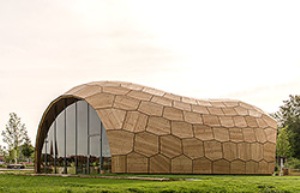With the help of a KUKA robot, a research project at the University of Stuttgart gave rise to a wooden pavilion that is characterized by its particular capabilities and efficient use of resources. The unusual pavilion can be visited at the State Garden Festival in Schwäbisch Gmünd, Germany until 12 October.
 The finalised pavilion at the State Garden Festival in Schwäbisch Gmünd (c) ICD/ITKE/IIGS Universität Stuttgart
The finalised pavilion at the State Garden Festival in Schwäbisch Gmünd (c) ICD/ITKE/IIGS Universität Stuttgart
The idea of joining one of the oldest building materials known to humanity using cutting-edge technology – in this case a KUKA robot from the KR QUANTEC series for shaping the components – comes from the University of Stuttgart.
Together with Müllerblaustein Holzbau GmbH, Landesgartenschau Schwäbisch Gmünd 2014 GmbH, the Baden‐Württemberg State Forestry Service (ForstBW) and KUKA, the academics from the south-west of Germany wanted to show how architecturally innovative and, at the same time, particularly effective designs made from the regionally available and renewable construction material can be – and how efficiently they use resources as well.
Inspiration: the sea urchin
The idea for the complex shape of the forest pavilion derives from nature, and more specifically the exoskeleton of a sea urchin. Its structure gives it particular capabilities and makes efficient use of materials. No one panel is the same as any other. In the forest pavilion, this means 243 different panels were drafted using computer-based planning. In this case, the panels were not modeled or drawn individually. Instead, their position, shape and size were determined automatically in the digital process. The greatest challenge and innovation involved producing the 7600 geometrically different finger joints that lend the pavilion its stability and are visible on the inside.
This is where the KUKA robot came into play. On a turntable, the KR QUANTEC robot cut the individual panels automatically and with the greatest of accuracy from 50 mm thick beech slabs. With an ideal result: when the pavilion was assembled, the parts fitted together perfectly, meaning that the unusual shape of the pavilion almost built itself. The entire construction process of the wooden pavilion can be seen here. The end result is on show at the State Garden Festival in Schwäbisch Gmünd until 12 October 2014.